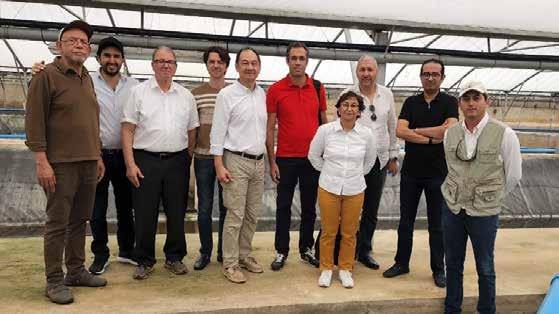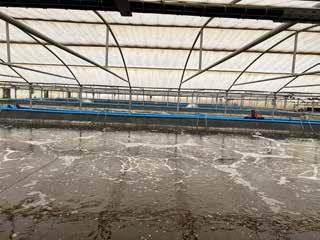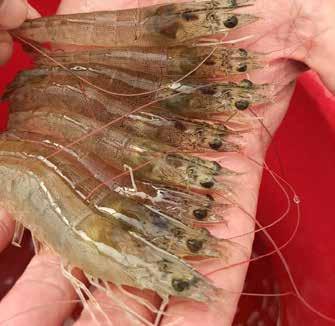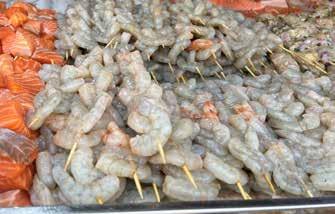
5 minute read
Debut of vannamei shrimp farming in Morocco
A pilot project with RAS and biofloc to test feasibility amidst climate and logistics challenges
By Zuridah Merican
Mly M’hamed Loultiti (third left) flanked by his sons, Ayoub and Youssef with USGC consultant in Morocco, Mustapha El Youssoufi (left); Aquaculture consultant Ronnie Tan (fifth left), Mohamed Salah Bouthour, Assistant Director for Africa (sixth left), Francisco Miranda Gutierrez (right) and visitors.
View of the several inflated greenhouses enclosing ponds and laboratory facilities for water quality and disease monitoring.
The Moroccan government has an aquaculture development plan that is in its early stages. The aim of the newly created National Agency for Aquaculture Development (ANDA) is to take advantage of the 3,500km coastline. At the same time, members of the agriculture cooperative, COPAG, have been looking at aquaculture to valorise reservoir ponds for the irrigation of farmlands spread all over the country. The idea is to use the ponds efficiently prior to their use for irrigation. COPAG, established in 1987, is the largest agglomeration of producers involved in agricultural and commercial activities for plant and animal products, including milk and its derivatives. Leading the way is its President, Mly M’hamed Loultiti who recently decided to run a pilot vannamei shrimp farming project. His first investment to demonstrate the feasibility of vannamei shrimp farming is a one ha project in domaine Mazaria. Loultiti has also designated more areas to expand this pilot project before moving to the planned commercial farm, near Moulay Bousselham.
Recognising the interest of Morocco’s agriculture players to diversify into aquaculture, the US Grains Council (USGC) sponsored the first mission of aquaculture experts in 2017. For land-based aquaculture, the expert advice is to farm Nile tilapia and vannamei shrimp. “Morocco has a privileged market with its main economic partners, benefiting from its proximity. Spain imports 185,000 tonnes of vannamei shrimp, mainly from Latin America. Tilapia will be for the local market but an export potential depends on the production of quality products. Most of the water resources are destined for agriculture but prior to this, we can valorize these resources for aquaculture,” said Dr Mustapha El Youssoufi, USGC’s consultant in Morocco. In August, Mustapha organised another mission, this time including USGC’s aquaculture consultant, Ronnie Tan. Together with Loultiti and his team, they discussed approaches for the project’s next steps.
Pilot farm
The planning of this pilot farm is the responsibility of a group of aquaculture professionals comprising Fernando Huertas from Ecuador, Florida-based Dr Darryl Jory and Spanish Colombian aquaculture entrepreneur Francisco Miranda Gutierrez, fondly known as Paco. Other than which culture system to adopt, the main consideration is temperature – during the day, the ambient temperature is 26°C declining to 16-17°C at night. Paco said, “This is the biggest challenge to overcome because we do not use electricity or gas to keep the water temperature at 30°C. In winter, the temperature is very cold at 4°C at night and 14°C in the daytime.”
There are six ponds covered by 1mm thick HDPE liners with water flowing via gravity to a treatment pond positioned in between them in an inflated 8000m2 greenhouse. Biofloc and recirculating aquaculture system (RAS) technology was chosen. Paco explained that this is a hybrid system, biofloc and MBBR biofilters. Floc volume is kept at 12ml/L. Female tilapia is cultured in the treatment ponds to control larvae of midge flies which are present in the organic matter mud in the digester. The digester in the treatment ponds



Grow-out ponds (left) and right, the treatments ponds with barriers to slow water flow and settle solids. Tilapia is stocked to control larvae of midge flies which are present in the organic matter in the digester.
helps to clarify the water, stabilise pH at 7.5 to pH8 and alkalinity at 160-220ppm. Denitrification accomplished in anoxic conditions frees alkalinity. Therefore, we do not need to add NaHCO3. Water returning to the ponds is clear of suspended solids,” added Paco.
Enclosed within an inflated greenhouse, the water temperature is maintained at 30°C. “I continue to experiment with pond depths at 1.5m and 2.3m. In the 2.3m deep ponds, the volume is 900m3 and I stock 250,000 post larvae (PL). According to Robins McIntosh, CPF, the ideal stocking should be 5kg/m3 to take advantage of the whole water column. “Our goal is only a maximum of 4kg/m3, basically because we are working with artificial seawater.”
Logistics is a challenge for this project, both for post larvae and feed. The source of post larvae came from Charoen Pokhand’s facility in Florida, USA, but poor flight scheduling in 2021 resulted in high mortality for the first consignment. With better planning, the second batch which came as PL4 was successful. Nevertheless, Paco is not happy with the high freight cost for post larvae supplies. Furthermore, there was also non-uniform growth when stocked directly in the ponds. He is now planning to import nauplii and grow to post larvae (PL25) before stocking.


In terms of disease and water management, Paco has not detected Vibrio parahaemolyticus but only the presence of Vibrio alginolyticus.
Commercial-scale production and markets
The 50ha commercial farm will be a modular design developed in 5 phases. Ponds will be covered and the projected productivity is 3kg/m3. There will be 3-4 cycles/ year. Loultiti has also planned the potential markets – the fresh and live shrimp market around Barcelona, Spain, the most accessible and nearest European country. The company is already well established in the export of fresh fruits to markets in Europe. The team discussed at length the logistics of exporting live and fresh shrimp as well as certifications to enter markets in Europe.
There is a thriving local demand for shrimp. A survey at a supermarket in Marrakech indicated a retail market for frozen peeled vannamei shrimp (size 31/40) imported from India priced at MAD 155/kg (USD14.1/kg) and MAD 60/kg (USD5.5/kg) for size 50/70. Imports of frozen HOSO black tiger shrimp (21/30) from Bangladesh retail at MAD140/kg (USD12.8/kg). Cooked locally caught shrimp size 50/kg is sold at MAD 149/kg (USD13.6/kg). Additionally, there are seafood restaurants with fresh raw peeled shrimp on the menu aside from salmon portions, whole bar, seabass and sole.
A seafood restaurant in Marrakech offers fresh seafood including peeled fresh vannamei shrimp at MAD100/kg (USD10/kg) and Argentinian shrimp at MAD 270/kg (USD24.6/kg).










